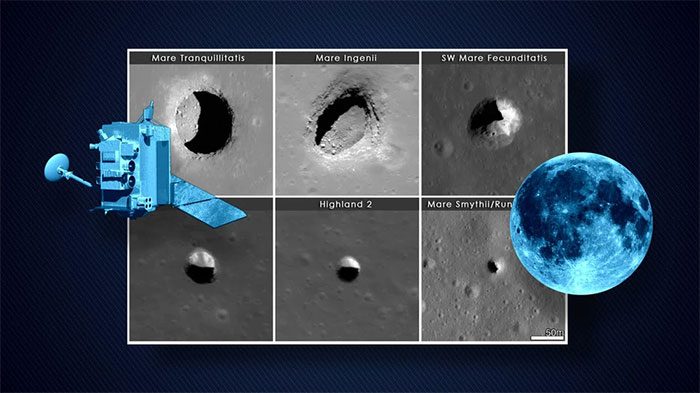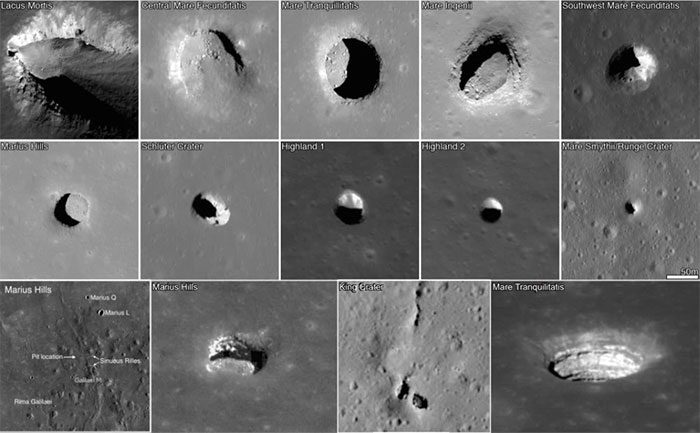Conquering the Moon: A Major Strategy for China
Caves have long served as the first shelters for humanity. In the 21st century, we have returned to explore the Moon. The discovery of various “caves” on the Moon may provide us with protection, much like how caves once sheltered our ancestors on Earth.
China is considering a bold idea: Building an underground base on the Moon.

Images from the Lunar Reconnaissance Orbiter show craters on the Moon’s surface. (Photo: NASA’s Goddard Space Flight Center/D. Gallagher).
According to new observations from the Lunar Reconnaissance Orbiter (LRO) of NASA, despite the Moon’s surface being covered with millions of craters, it also has over 200 “caves”—natural openings formed by cooled lava tubes, which create openings several hundred meters in diameter on this celestial body, as reported by Scitechdaily.
The craters range in diameter from approximately 5 meters to 900 meters, with three of them identified for the first time through images from Japan’s Kaguya spacecraft.
Hundreds of additional images were discovered using new computer algorithms that automatically scanned thousands of high-resolution images of the Moon’s surface from the Narrow Angle Camera (NAC) of the LRO.
The idea is to construct an underground base beneath the cooled lava tubes on the Moon.
Lava tubes, also known as pyroducts, form when lava flowing on the Moon’s surface begins to cool.
The upper part cools to form a hard crust, while the molten lava underneath continues to flow until it is drained by the Moon’s gravity, leaving behind a hollow tube. A similar process occurs on Earth.
Hazards on the Moon
Scientists are aware that astronauts on the Moon will need protection from various hazards.
They will face sudden temperature fluctuations, cosmic and solar radiation, and even impacts from meteorites.
On the Moon, astronauts will contend with temperature changes. The natural satellite of Earth experiences extremely high temperatures during the day and extremely cold temperatures at night.
Daytime temperatures on the Moon’s surface can reach up to 127 degrees Celsius, while at night, they can drop to -173 degrees Celsius.
Nighttime temperatures in the polar regions of the Moon can even plummet to -200 degrees Celsius, as reported by Universetoday.
This temperature disparity makes working and living on the Moon’s surface, as well as creating equipment that can function effectively in such an environment, exceedingly difficult.

These images from the Lunar Reconnaissance Orbiter show craters on the Moon’s surface. (Photo: NASA/GSFC/Arizona State University).
However, lava tubes can mitigate these challenges. They provide a naturally stable temperature environment not found elsewhere on the Moon.
Cosmic radiation is also quite hazardous on the Moon’s surface, potentially being 150 times stronger than on Earth.
This poses a significant danger, but within the Moon’s lava tubes, astronauts would be protected by several meters of overhead rock. This thick barrier effectively shields against cosmic radiation.
The risk of collisions with small asteroids is much lower, but it still needs to be accounted for. Clearly, lava tubes offer excellent shelter against impacts from space.
China’s Bold Idea
Research teams from various countries and space agencies have studied the idea of using lava tubes as shelters for humans on the Moon.
At a recent conference in China, Dr. Zhang Chongfeng from the Shanghai Academy of Space Technology presented a study on the “underground world” of lava tubes.
According to Dr. Zhang, there are sufficient similarities between the lava tubes on the Moon and those on Earth. Thus, China has conducted field studies on its own lava tubes to understand how to utilize them on the Moon.
Most of what we find on the Moon are vertical lava tubes, but this may be due to our overhead view. Accessing these locations would require flying or using some type of vertical lifting equipment.
For lava tubes with sloping entrances, entry will be easier compared to the others. According to Dr. Zhang, this provides a more accessible way for exploration.
At the conference, China indicated that it is prioritizing the exploration of the Moon’s lava tubes at Mare Tranquillitatis (Sea of Tranquility) and Mare Fecunditatis (Sea of Fertility).
The country plans to develop a robotic system capable of exploring the lava tubes like caves in Mare Tranquillitatis.
This robotic system will be designed to adapt to challenging terrain and overcome obstacles. It will also be equipped with scientific instruments.
Additionally, China is planning to create a flying robot that can autonomously navigate through the lava tubes using microwave radar and lasers.
The future plan for China, following successful exploration, is to build a crewed base.

Location of Mare Tranquillitatis on the Moon. (Photo: Lunarregistry).
This will be a long-term underground research facility located within one of the Moon’s lava tubes, with a power and communication support center at the tube’s entrance.
Many observers note that China’s space program is currently thriving, with numerous successful missions completed, some still ongoing, and future missions planned.
Ding Lieyun, a leading scientist at Huazhong University of Science and Technology, stated: “Ultimately, constructing a habitat beyond Earth is essential not only for the exploration journey of humanity but also for China’s strategic needs as a space power.”
To prepare for various lunar missions, Chinese scientists have studied both Mare Tranquillitatis and Mare Fecunditatis.
In 2022, a team of scientists published a study on the volcanic characteristics of Mare Fecunditatis in the journal Remote Sensing.
China is not the first country to propose the idea of using lava tubes as underground bases. This concept has been around for a long time.
However, it won’t be long before China and other spacefaring nations can explore them and seriously begin constructing habitats for human living and working.


















































